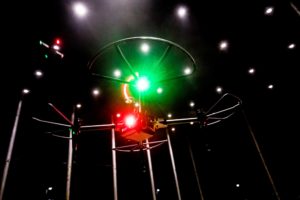 The University of Michigan is flying high following Saturday’s Final Four victory, but Wolverine engineering students are already taking autonomous drone testing to national-champ levels.
The University of Michigan is flying high following Saturday’s Final Four victory, but Wolverine engineering students are already taking autonomous drone testing to national-champ levels.
In 2017, the university’s College of Engineering began work on M-Air, an outdoor fly lab created to test autonomous aerial vehicles. Now, the four-story drone-testing complex is open for business.
“M-Air will let researchers and students safely push algorithms and equipment to their limits,” says UM aerospace engineering professor Ella Atkins said in a university news release.
“I believe M-Air will rapidly become an incubator for new aerial vehicle concepts,” Atkins added.
The facility is netted to avoid any safety issues with errant drones. The lab affords researchers with an indoor lab space to develop drone and other robotics projects. The building includes a three-story fly zone where drones can perch on walls or ceilings and interact with the environment. Atkins adds:
“With this facility, we can pursue aggressive educational and research flight projects that involve high risk of fly-away or loss-of-control—and in realistic wind, lighting and sensor conditions. We also can begin to better understand operational risks associated with real-world outdoor flights with no real risk to people or other aircraft outside the net.”
Because university policy dictates a formal, laborious approval process for outdoor drone flight that could hamper research efforts, having a netted facility will classify test flights as “indoor” — not subject to the policy.
Larger autonomous drones can fly missions for commercial transport and national security, while smaller UAVs can inspect infrastructure as well as data mining environmental and meteorological phenomena.
Last week, a team led by engineering professor Dimitrios Zekkos tested a drone by dropping a 15-pound weight to measure ground shockwaves, yielding insightful data about underground conditions.
“Much of what we see at the surface—whether it is a failure of a bridge, a landslide, or a structural collapse—may be caused by failure at depth,” Zekkos said.
“The problem is that some of these areas, immediately after the event, are unsafe and sometimes impossible to reach. This work can inform risk assessment studies, urban planning and other critical decisions and processes. It could also lead to better design procedures and, eventually, safer structures.”
Jason is a longstanding contributor to DroneLife with an avid interest in all things tech. He focuses on anti-drone technologies and the public safety sector; police, fire, and search and rescue.
Beginning his career as a journalist in 1996, Jason has since written and edited thousands of engaging news articles, blog posts, press releases and online content.
Email Jason
TWITTER:@JasonPReagan
Subscribe to DroneLife here.







[…] Source link […]